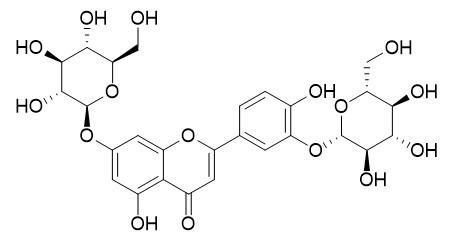Luteolin-3',7-di-O-glucoside
Luteolin-3',7-di-O-glucoside has anti-ulcer and antioxidant activities.
Inquire / Order:
manager@chemfaces.com
Technical Inquiries:
service@chemfaces.com
Tel:
+86-27-84237783
Fax:
+86-27-84254680
Address:
1 Building, No. 83, CheCheng Rd., Wuhan Economic and Technological Development Zone, Wuhan, Hubei 430056, PRC
Providing storage is as stated on the product vial and the vial is kept tightly sealed, the product can be stored for up to
24 months(2-8C).
Wherever possible, you should prepare and use solutions on the same day. However, if you need to make up stock solutions in advance, we recommend that you store the solution as aliquots in tightly sealed vials at -20C. Generally, these will be useable for up to two weeks. Before use, and prior to opening the vial we recommend that you allow your product to equilibrate to room temperature for at least 1 hour.
Need more advice on solubility, usage and handling? Please email to: service@chemfaces.com
The packaging of the product may have turned upside down during transportation, resulting in the natural compounds adhering to the neck or cap of the vial. take the vial out of its packaging and gently shake to let the compounds fall to the bottom of the vial. for liquid products, centrifuge at 200-500 RPM to gather the liquid at the bottom of the vial. try to avoid loss or contamination during handling.
Planta Med.2018, 84(6-07):465-474
JEJU National University2022, 24032.
Hum Exp Toxicol.2022, 41:9603271221143713.
Molecules.2019, 24(12):E2286
Plants (Basel).2023, 12(6):1259.
Biochem Biophys Res Commun.2020, 527(4):889-895.
Food Sci Biotechnol.2016, 25(5):1437-1442
J.of Traditional&Complementary Med.2022, 10.1016:j.jtcme.
Fitoterapia.2022, 105141.
Pharmacognosy Magazine2017, 13(52):868-874
Related and Featured Products
Nat Prod Res. 2015;29(17):1673-7.
Antioxidant activities and quali-quantitative analysis of different Smallanthus sonchifolius [(Poepp. and Endl.) H. Robinson] landrace extracts.[Pubmed:
25533266 ]
Five landraces of Smallanthus sonchifolius [(Poepp. and Endl.) H. Robinson], known as yacon, were investigated in total phenolic content, antioxidant activity and chemical composition of ethanol extracts (EEs) and decoction extracts (DEs).
METHODS AND RESULTS:
The results demonstrated that DEs are rich in phenolic acids as caffeic acid, while the EEs show an higher amount of flavonoids, as luteolin 3',7-O-diglucoside and luteolin 7-O-glucoside. These flavonoid glycosides were identified for the first time in yacon extracts, together with apigenin and luteolin. The phytochemical profile explains the different antioxidant activities shown in our study.
CONCLUSIONS:
The landraces PER6-DE and PER4-DE showed the highest radical-scavenging activity and reducing power related to their polyphenolic contents. Results also show that yacon can be considered an important source of bioactive compounds with significant differences among the analysed landraces.
J Ethnopharmacol. 2014 Nov 18;157:1-6.
Antiulcer activity of the ethanolic extract and ethyl acetate fraction of the leaves of Markhamia tomentosa in rats.[Pubmed:
25240588]
The leaves of Markhamia tomentosa (Benth.) K. Schum. Ex Engl. (Bignoniaceae) are used traditionally in the treatment of skin afflictions, sores, ulcers and inflammation. The aim of the study was to investigate the antiulcer activity of the crude ethanolic extract from the leaves of Markhamia tomentosa, determine the active fraction(s) of the extract and identify the chemical constituents in the active fraction by LC-MS.
METHODS AND RESULTS:
The antiulcer activity of the crude extract (50, 100 and 150mg/kg, p.o.) was evaluated in ethanol and indomethacin-induced models while the solvent fractions (150mg/kg) were screened using ethanol-induced gastric lesions in rats. Furthermore, anti-ulcer activity of the active fraction (50, 100 and 150mg/kg, p.o.) was performed using indomethacin and pylorus ligation models. Parameters such as gastric volume, pH and acidity were determined in the pylorus ligation model. LC-ESI-MS analysis was used to identify the components in the active fraction.
The extract at the dose of 50, 100 and 150mg/kg caused a significant (p<0.05) dose-dependent inhibition of ulcer in the ethanol and indomethacin-induced ulcer models, respectively. The ethyl acetate (EtOAc) fraction showed the most potent antiulcer activity from all the fractions tested. This fraction produced 72% and 92% inhibition of indomethacin and pylorus-induced ulcer at a dose of 150mg/kg respectively. Acteoside, luteolin, luteolin-7-rutinoside, Luteolin-3',7-di-O-glucoside, carnosol, dilapachone, tormentic acid, oxo-pomolic acid and ajugol were detected in the EtOAc fraction.
CONCLUSIONS:
Our data provide a rational base for the folkloric use of Markhamia tormentosa in the treatment of ulcers.



